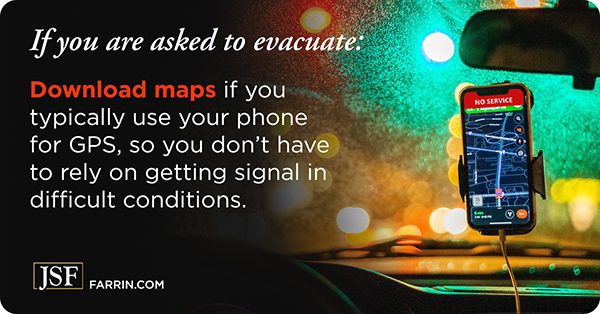The Southeast has felt the brunt of many hurricanes and tropical storms throughout the years, which have brought with them plenty of property damage and hazardous driving conditions.
It’s best to avoid driving in hurricane-related conditions, such as heavy rain and high winds, as much as possible. But if you can’t, please take extra precautions for everyone’s safety – including your own.
Have an Evacuation Plan
One of the most important ways to prepare for a hurricane is to have an evacuation plan – especially if you are along the coast or in low-lying areas. And when evacuation orders are issued, please heed them.
Know what route you are going to take and have it easily accessible.
- Download maps if you typically use your phone for GPS, so you don’t have to rely on getting signal in difficult conditions. Here are instructions for how to download Google maps onto your Android or iPhone.
How to Prepare Your Car for a Hurricane
There are a few things you can do to your car in the days leading up to a hurricane that can make a big difference in the event that you have to drive.
- Check tire tread and inflation. Tires should have proper inflation and the tread should have more than 2/32-inch.An easy way to check the tread depth is to insert a penny into each groove with Lincoln’s head upside down. If you can see all of Lincoln’s head (including his hair), you need new tires. Consult your car manual to check for the proper tire pressure for the recommended tires. NHTSA offers many other tire safety facts.
- Use a rain repellent on your windshield, side windows, and mirrors to clear standing raindrops.
- Build a car emergency kit. At the very least, have a flashlight, window breaker tool, and seatbelt cutter or Swiss army knife. The National Hurricane Center offers more information on hurricane safety kits.
- Tips to Help You Drive Safer in Hurricane Conditions
Again, the best thing to do is to avoid driving in a hurricane, but if you absolutely have to, these tips may help you avoid a car accident.
Driving in Heavy Rain
- Do not use cruise control. When you are not in cruise control and you lift your foot off the gas to brake, the front of your car starts to dip a bit, transferring some weight to the front. This gives the front tires more traction. In cruise control, the car doesn’t dip when you brake. Instead, the speed remains constant so you lose that early weight transfer and can more easily lose control of the car.
- Drive in “ruts.” If the roadway develops “ruts” where the heaviest traffic tracks, try to drive within them while remaining in your lane to avoid pools of water. This makes it easier for your tires to handle the water.
- Remain calm if you hydroplane. If you feel the car begin to skid, remain calm and steer in the direction where you want the car to go. Don’t slam on the brakes as this will further upset the vehicle’s balance and make it harder to control. Most hydroplane skids last for just a split second before your car regains traction. Waiting it out is the best way to handle the situation. Don’t make sudden turns or motions, let off the gas, and steer straight or slightly in the direction you are heading. Keep a steady hand on the wheel and steer with small movements to correct your course.
- Pump breaks. Wet drum-type brakes are especially prone to decreased stopping power after driving through deep water. Occasionally pump your brakes gently to help dry them and make sure they work.
- Never drive through high water. Cars can be swept off the road in only a foot of moving water, and roads covered by water can collapse. Driving through high water may stall your engine, which can cause irreparable damage to your car if you try to restart it. If you come upon a flooded street, take an alternate route. If you cannot, The Weather Network has tips on how to proceed with caution.
- Never ever drive through water with a downed electrical line. If you see any utility poles down or other indications that an electrical line may be down, stop immediately and take a different route.
Driving in Windy Conditions
- Expect gusts. Take special care when driving through areas prone to strong winds, such as wide open areas, bridges, and overpasses. If the wind begins to move you, gently steer back in the direction you want to go.
- Be vigilant near larger vehicles. Tractor-trailers and recreational vehicles are more susceptible to high winds, and drivers may have difficulty staying in their lanes.
- Keep a firm grip on the wheel. Keep both hands on the wheel in case the wind begins to move your vehicle, especially if you are driving a large vehicle or towing a trailer.
Driving Defensively in Hazardous Weather
- Slow down. Rule of thumb: reduce your speed by 10 mph each time you increase your windshield wiper speed. Driving slower reduces your risk of losing contact with the road and can possibly help keep you from hydroplaning.
- Stay 5 seconds behind the car in front of you. Watch the car in front of you as it passes a fixed object, like a light or utility pole. Then count 5 seconds. If you reach your marker before 5 seconds, you may be too close for a sudden emergency.
- Pay attention to the front, sides, and back of you. Be aware of falling or flying debris, electrical wires, mudslides, puddles, swerving cars, and anything that may cause you to lose control of your car.
- Turn off cell phones and the radio. Don’t do anything that distracts you from driving. You need to be extra cautious and vigilant while driving in slick, windy conditions.
- Turn on your headlights. Even in daylight. Besides, it’s the law in many states, including North and South Carolina. Remember: wipers on, lights on.
Get a Free Case Evaluation From Our North Carolina Car Accident Lawyers
If you are injured in a car crash, we strongly urge you to contact us or call 1-866-900-7078. We will evaluate your situation for free and let you know if we think we can help.
- We are one of the largest personal injury law firms in North Carolina and have many resources to draw from.
- We have recovered over $2 billion1 total for more than 73,000 clients since 1997.
- We have more than 200 staff members and more than 60 attorneys.
- Many of our lawyers have achieved peer- and client-based awards and designations. (See for yourself some of the things clients have to say about us.)
You May Also Be Interested In
How to Drive in the Snow in North Carolina (And Other Safety Tips for Wintry Road Conditions)
Why You Should Get a Free Case Evaluation if You’ve Been Injured
Weather and Auto Accidents – Frequently Asked Questions (and Answers)


 Know what route you are going to take and have it easily accessible.
Know what route you are going to take and have it easily accessible.
